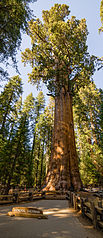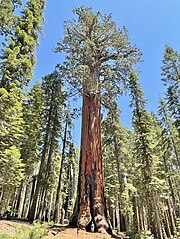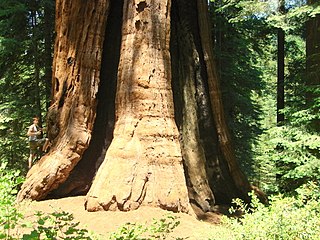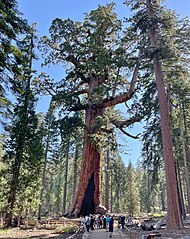The giant sequoia (Sequoiadendron giganteum) is the world's most massive tree,[1][2] and arguably the largest living organism on Earth.[3] It is neither the tallest extant species of tree (that distinction belongs to the coast redwood),[4][5] nor is it the widest (that distinction belongs to the African baobab or the Montezuma cypress), nor is it the longest-lived (that distinction belongs to the Great Basin bristlecone pine).[6] However, with a height of 87 meters (286 ft) or more, a circumference of 34 meters (113 ft) or more, an estimated bole volume of up to 1,490 cubic meters (52,500 cu ft), and a documented lifespan of 3266 years, the giant sequoia is among the tallest, widest, and longest-lived of all organisms on Earth.

Giant sequoias grow in well-defined groves in California mixed evergreen forests, along with other old-growth species such as California incense cedar. Because most of the neighboring trees are also quite large, it can be difficult to appreciate the size of an individual giant sequoia. The largest giant sequoias are as tall as a 26-story building, and the width of their bases can exceed that of a city street. They grow at such a rate as to produce roughly 1.1 cubic meters (40 cu ft) of wood each year, approximately equal to the volume of a 50-foot-tall tree one foot in diameter.[7] This makes them among the fastest growing organisms on Earth, in terms of annual increase in mass.
Distribution

Giant sequoias occur naturally in only one place on Earth—the western slope of the Sierra Nevada mountain range in California, on moist, unglaciated ridges and valleys[8] at an altitude of 1,500 to 2,400 meters (5,000 to 8,000 ft) above mean sea level. There are 65–75 groves of giant sequoias in the Sierra Nevada, depending upon the criteria used to define a grove.[2][9] The northernmost of these groves is Placer County Big Trees Grove in the Tahoe National Forest, Placer County, California,[10] while the southernmost grove is Deer Creek Grove in the Giant Sequoia National Monument, Tulare County, California.[9] The combined total area of all groves of giant sequoias is approximately 14,400 hectares (35,600 acres).[11]
Fire limits growth
Giant sequoias are in many ways adapted to forest fires. Their bark is unusually fire resistant, and their cones will normally open immediately after a fire.[12] However, fire is also the most serious damaging agent of giant sequoias. Seedlings and saplings are highly susceptible to death or serious injury by fire. Larger giant sequoias are more resistant to fire damage, due to their thick protective layer of nonresinous bark and elevated crowns. However, repeated fires over many centuries may penetrate the bark and destroy the vascular cambium. Nearly all of the larger trees have fire scars, many of which cover a large area of the base of the tree. Older trees are rarely killed by fire alone, but the resulting structural damage may predispose a tree to collapse and fire scars also provide entry for fungi which may cause root disease and heart rot. The resulting decayed wood is then more easily consumed by subsequent fires. The result of this cycle is further structural weakening of the tree, which may eventually lead to its collapse.[13]


Fire scars are thought to be the main cause of dead tops. Although lightning strikes rarely kill mature trees, lightning sometimes knocks out large portions of crowns or ignites dead tops. The most common cause of death in mature giant sequoias is toppling, due to weakening of the roots and lower trunk by fire and decay. The extreme weight of the trees coupled with their shallow root systems contributes to this weakening. Other causative factors include wind, water-softened soils, undercutting by streams, and heavy snow loads in the crowns.[13]
The Washington tree, located in the Giant Forest Grove in Sequoia National Park provides a good example of the aforementioned phenomenon. This tree was the second-largest tree in the world (only the General Sherman tree was larger) until September 2003, when the tree lost a portion of its crown as a result of a fire caused by a lightning strike.[1][14] This reduced its height from nearly 78 meters (255 ft) to about 70 meters (229 ft). The structurally weakened tree partially collapsed in January 2005, as the result of a heavy snow load in the remaining portion of its crown; it is now approximately 35 meters (115 ft) tall.[1][15]
Tree measurement
As with other trees, measurement of giant sequoias is conducted using established dendrometric techniques. The most frequent measurements acquired in the field include the height of the tree, the horizontal dimension of its canopy, and its diameter at breast height (DBH). These measurements are then subjected to tree allometry, which employs certain mathematical and statistical principles to estimate the amount of timber volume in a tree.
Calculating the volume of a standing tree is the practical equivalent of calculating the volume of an irregular cone,[16] and is subject to error for various reasons. This is partly due to technical difficulties in measurement, and variations in the shape of trees and their trunks. Measurements of trunk circumference are taken at only a few predetermined heights up the trunk, and assume that the trunk is circular in cross-section, and that taper between measurement points is even. Also, only the volume of the trunk (including the restored volume of basal fire scars) is taken into account, and not the volume of wood in the branches or roots.[16] The volume measurements also do not take cavities into account. For example, while studying sequoia tree canopies in 1999, researchers discovered that the Washington tree in Giant Forest Grove was largely hollow.[15]
List of largest giant sequoias by trunk volume
The following table is a list of the largest giant sequoias, all of which are located in California. The table is sorted by trunk volume, ignoring wood in the branches of the tree.
indicates a giant sequoia that sustained heavy fire damage after its most recent volume estimate.
| Rank | Name | Location[17] | Coordinates | Height[17] | Circumference[17] | Bole Volume[17] | Comments | Ref |
|---|---|---|---|---|---|---|---|---|
| 1 | General Sherman | Giant Forest Grove | 36°34′51″N 118°45′03″W / 36.58083°N 118.75083°W | 83.8 m (274.9 ft) | 31.3 m (102.6 ft) | 1,486.9 m3 (52,508 cu ft) | Named after William Tecumseh Sherman. | [18][16][19] |
| 2[note 1] | General Grant | General Grant Grove | 36°44′53″N 118°58′15″W / 36.74806°N 118.97083°W | 81.7 m (268.1 ft) | 32.8 m (107.5 ft) | 1,319.8 m3 (46,608 cu ft)[note 1] | Named after Ulysses S. Grant; designated as the "Nation's Christmas Tree" since 1926. | [20][21] |
| 3[note 1] | President | Giant Forest Grove | 36°34′24″N 118°45′00″W / 36.57341°N 118.75010°W | 73.4 m (240.9 ft) | 28.3 m (93.0 ft) | 1,278.4 m3 (45,148 cu ft)[note 1] | Named after U.S. President Warren G. Harding. | [24] |
| 4 | Lincoln | Giant Forest Grove | 36°34′19″N 118°45′22″W / 36.57187°N 118.75604°W | 78.0 m (255.8 ft) | 30.0 m (98.3 ft) | 1,259.3 m3 (44,471 cu ft) | Named after Abraham Lincoln. | [25] |
| 5 | Stagg | Alder Creek Grove | 36°11′29″N 118°37′08″W / 36.19131°N 118.61878°W | 74.1 m (243.0 ft) | 33.2 m (109.0 ft) | 1,205.1 m3 (42,557 cu ft) | Named after Amos Alonzo Stagg. | [26] |
| 6 | Boole | Converse Basin Grove | 36°49′26″N 118°56′57″W / 36.82389°N 118.94917°W | 81.9 m (268.8 ft) | 34.4 m (113.0 ft) | 1,202.7 m3 (42,472 cu ft) | Named after Franklin A. Boole. The tree has the largest footprint of any living giant sequoia. | [25] |
| 7 | Genesis | Mountain Home Grove | 36°12′54″N 118°40′10″W / 36.215119°N 118.669395°W | 77.1 m (253.0 ft) | 26.0 m (85.3 ft) | 1,186.4 m3 (41,897 cu ft) | Named after Genesis. Heavily damaged by the Castle Fire. | [27][28] |
| 8 | Franklin | Giant Forest Grove | 36°34′04″N 118°45′31″W / 36.56771°N 118.75864°W | 68.2 m (223.8 ft) | 28.9 m (94.8 ft) | 1,169 m3 (41,280 cu ft) | Named after Benjamin Franklin. Located near Washington. | [25] |
| 9 | King Arthur | Garfield Grove | 36°19′42″N 118°43′01″W / 36.32838°N 118.71703°W | 82.4 m (270.3 ft) | 31.8 m (104.2 ft) | 1,151.2 m3 (40,656 cu ft) | Named after King Arthur. Destroyed in the Castle Fire. | [25][29] |
| 10 | Monroe | Giant Forest Grove | 36°33′26″N 118°46′10″W / 36.55710°N 118.76939°W | 75.5 m (247.8 ft) | 27.8 m (91.3 ft) | 1,135.6 m3 (40,104 cu ft) | Named after James Monroe, located near Auto Log. | [25] |
| 11 | Robert E. Lee | General Grant Grove | 36°44′53″N 118°58′16″W / 36.7480°N 118.9711°W | 77.6 m (254.7 ft) | 26.9 m (88.3 ft) | 1,135.6 m3 (40,102 cu ft) | Named after Robert E. Lee. | [25] |
| 12 | Floyd Otter | Garfield Grove | 36°19′39″N 118°43′01″W / 36.32748°N 118.71696°W | 83.2 m (273.1 ft) | 30.3 m (99.5 ft) | 1,120.3 m3 (39,562 cu ft) | Named after Floyd Otter, a former manager of the Mountain Home Demonstration State Forest. Possibly heavy damage from Castle Fire. | [25][30] |
| 13 | John Adams | Giant Forest Grove | 76.4 m (250.6 ft) | 25.4 m (83.3 ft) | 1,103.1 m3 (38,956 cu ft) | Named after John Adams, located near Cattle Cabin. | [25] | |
| 14 | Ishi Giant | Kennedy Grove | 36°45′41″N 118°48′38″W / 36.76143°N 118.81062°W | 75.6 m (248.1 ft) | 32.0 m (105.1 ft) | 1,080.5 m3 (38,156 cu ft) | Lost significant trunk volume and over 8 m (26 ft) in height during the 2015 Rough Fire. New volume and height estimates needed to determine the current size of the tree. | [31] |
| 15 | Column | Giant Forest Grove | 74.3 m (243.8 ft) | 28.3 m (93.0 ft) | 1,056.1 m3 (37,295 cu ft) | Located near Pershing. | [25] | |
| 16 | Summit Road | Mountain Home Grove | 36°13′41″N 118°40′16″W / 36.22813°N 118.67117°W | 74.4 m (244.0 ft) | 25.1 m (82.2 ft) | 1,040 m3 (36,600 cu ft) | Named after a nearby road. Possible heavy damage from the Castle Fire. | [25][32] |
| 17 | Euclid | Mountain Home Grove | 36°13′46″N 118°40′40″W / 36.22949°N 118.67776°W | 83.1 m (272.7 ft) | 25.4 m (83.4 ft) | 1,022.9 m3 (36,122 cu ft) | Named after Euclid. | [25] |
| 18 | Washington | Mariposa Grove | 37°30′54″N 119°35′53″W / 37.51507°N 119.59806°W | 71.9 m (236.0 ft) | 29.2 m (95.7 ft) | 1,016.6 m3 (35,901 cu ft) | The largest giant sequoia north of Boole. Named after George Washington. Not to be confused with the Washington tree of Giant Forest Grove. | [25] |
| 19 | Pershing | Giant Forest Grove | 36°34′43″N 118°45′12″W / 36.57869°N 118.75347°W | 75.0 m (246.0 ft) | 27.8 m (91.2 ft) | 1,015.3 m3 (35,855 cu ft) | Named after John J. Pershing. | [25] |
| 20 | Diamond | Atwell Mill Grove | 36°27′48″N 118°41′51″W / 36.46343°N 118.69740°W | 87.2 m (286.0 ft) | 29.0 m (95.3 ft) | 999.4 m3 (35,292 cu ft) | Named for a large diamond-shaped scar present on the southeastern side of the trunk. | [25] |
| 21 | Adam | Mountain Home Grove | 36°14′36″N 118°40′22″W / 36.243404°N 118.672651°W | 75.4 m (247.4 ft) | 28.7 m (94.2 ft) | 991.6 m3 (35,017 cu ft) | Named after Adam. | [33] |
| 22 | Roosevelt | Redwood Mountain Grove | 36°41′38″N 118°55′08″W / 36.69389°N 118.91889°W | 79.2 m (260.0 ft) | 24.4 m (80.0 ft) | 991.5 m3 (35,013 cu ft) | Named after Theodore Roosevelt. | [25] |
| 23 | Nelder | Nelder Grove | 37°26′29″N 119°35′47″W / 37.44127°N 119.59644°W | 81.1 m (266.2 ft) | 27.4 m (90.0 ft) | 990.9 m3 (34,993 cu ft) | Named after John A. Nelder. | [25] |
| 24 | Above Diamond (AD) | Atwell Mill Grove | 36°27′53″N 118°41′36″W / 36.46477°N 118.69341°W | 73.9 m (242.4 ft) | 30.2 m (99.0 ft) | 982.8 m3 (34,706 cu ft) | Situated just above Diamond, hence the name "AD". | [25] |
| 25 | Hart | Redwood Mountain Grove | 84.7 m (277.9 ft) | 23.0 m (75.3 ft) | 974.3 m3 (34,407 cu ft) | Named after Michael Hart, who discovered it. | [34][25] | |
| 26 | Grizzly Giant | Mariposa Grove | 37°30′12.65″N 119°36′2.39″W / 37.5035139°N 119.6006639°W | 63.7 m (209.0 ft) | 28.2 m (92.5 ft) | 962.9 m3 (34,005 cu ft) | Originally named the "Grizzled Giant" by Galen Clark. | [25] |
| 27 | Chief Sequoyah | Giant Forest Grove | 36°34′26″N 118°45′00″W / 36.57379°N 118.75°W | 69.6 m (228.2 ft) | 27.6 m (90.4 ft) | 951.7 m3 (33,608 cu ft) | Named after Sequoyah. | [25] |
| 28 | Methuselah | Mountain Home Grove | 36°14′25″N 118°40′49″W / 36.240254°N 118.680249°W | 63.3 m (207.8 ft) | 29.2 m (95.8 ft) | 931.5 m3 (32,897 cu ft) | Named after Methuselah. | [25] |
| 29 | Great Goshawk | Freeman Creek Grove | 77.8 m (255.2 ft) | 27.5 m (90.2 ft) | 928.3 m3 (32,783 cu ft) | The largest giant sequoia south of Stagg. Named after the Northern goshawk, a hawk native to the Sierra Nevada. | [25] | |
| 30 | Hamilton | Giant Forest Grove | 36°32′58″N 118°45′55″W / 36.54954°N 118.76517°W | 72.7 m (238.5 ft) | 25.2 m (82.6 ft) | 928.3 m3 (32,783 cu ft) | Named after Alexander Hamilton. | [25] |
| 31 | Dean | Atwell Mill Grove | 36°28′12″N 118°40′58″W / 36.46995°N 118.68276°W | 71.9 m (235.9 ft) | 29.4 m (96.4 ft) | 915.6 m3 (32,333 cu ft) | Named after a carving of the name "Dean" that was found on a charred area of the trunk by Wendell D. Flint in 1950. | [citation needed] |
| 32 | Black Mountain Beauty | Black Mountain Grove | 36°06′58″N 118°40′31″W / 36.11623°N 118.67518°W | 80.2 m (263.0 ft) | 23.2 m (76.0 ft) | 912.5 m3 (32,224 cu ft) | Also known as "Black Mountain Shaft". The tree lost significant volume after it burned during the 2017 Pier Fire. New volume estimate needed to determine the current volume of the tree. | [31] |
Notes
- The trees Named "Franklin", "Column", "Monroe", "Hamilton" and "Adams" were named by Wendell Flint and others. These five are now included on the official map of Giant Forest, where they are all situated.
- The Washington Tree (not listed above) was previously arguably the second largest tree with a volume of 1,354.96 m3 (47,850 cu ft) (although the upper half of its trunk was hollow, making the calculated volume debatable), but after losing the hollow upper half of its trunk in January 2005 following a fire, it is no longer of exceptional size. Some sources leave open the possibility that this tree may have been larger than even General Sherman in the past[35]
- The Hazelwood Tree (not listed above) had a volume of 1,025.86 m3 (36,228 cu ft) before losing half its trunk in a lightning storm in 2002, if it were still at full size it would currently be the 17th largest giant sequoia on earth.
- The largest giant sequoia killed at the hands of man was the Discovery Tree at Calaveras Grove, which was cut down a year after its discovery.[36] Another tree nearby, the huge Mother of the Forest, was mortally wounded when its bark was removed to be put on display on the East Coast.
- The largest giant sequoia ever recorded, as well as potentially the largest tree which ever lived, was the Father of the Forest from Calaveras Grove. The exceedingly enormous tree collapsed centuries ago, and its still relatively well-preserved remains have turned into a popular tourist attraction. The tree was reportedly over 400ft tall and 110ft in circumference when it fell.[37][38]
Several of the largest sequoia trees
- Base of Stagg
- 11th largest giant sequoia by trunk volume
See also
Notes
References
Further reading
- Cook, LF (1955). The Giant Sequoias of California. Washington, D.C.: United States Government Printing Office.
- Dilsaver, LM; Tweed, WC (1990). Challenge of the big trees:a resource history of Sequoia and Kings Canyon National Parks (1st ed.). Three Rivers, California: Sequoia Natural History Association. ISBN 978-1-878441-00-3.
- Otter, FL; Dulitz, DJ; Otter, JI; Otter, MK (2007). The history of a giant sequoia forest: the story of Mountain Home Demonstration State Forest. Springville, California: self-published. ISBN 978-0-9614459-3-5.
- Swetnam, TW (1993). "Fire History and Climate Change in Giant Sequoia Groves (abstract)". Science. 262 (5135): 885–9. doi:10.1126/science.262.5135.885. PMID 17757357. S2CID 43064334.
External links
 Media related to Sequoiadendron giganteum (named individual trees) at Wikimedia Commons
Media related to Sequoiadendron giganteum (named individual trees) at Wikimedia Commons













